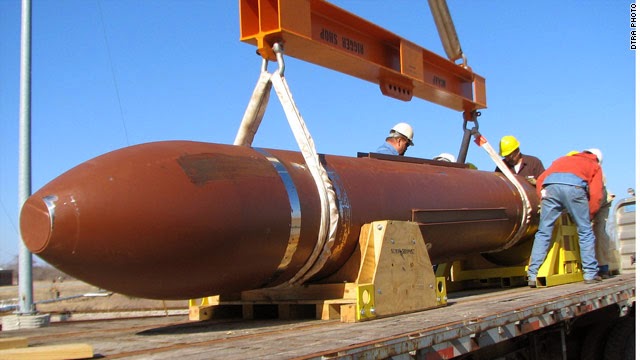The Pentagon has upgraded and tested the largest bunker-buster bomb in the U.S. arsenal, senior U.S. officials said, readying a weapon that could destroy or disable Iran’s most heavily fortified nuclear facilities should a nuclear deal fall apart and the White House decide to take military action.
The Pentagon declined to comment on any improvements to the so-called Massive Ordnance Penetrator, or MOP.
The Wall Street Journal reported in 2012 that Pentagon war planners had concluded that the 30,000-pound bunker buster wasn’t powerful enough to destroy certain hardened Iranian nuclear facilities and ordered steps to be taken to upgrade the bomb’s design and guidance systems. In 2013, the Journal reported the weapon was being redesigned.
The weapon was last tested in recent months, including in January, and senior officials say the results show the bomb—when dropped one on top of the other—is now more capable of penetrating fortified nuclear facilities in Iran or in North Korea.
Officials said work on improving the MOP is continuing, but the weapon has performed well in the tests, allaying the concerns officials had two years ago.
To destroy or disable the underground facilities, the Pentagon envisages guiding two or more of the bunker busters to the same impact point, in sequence, extending the weapon’s burrowing power, the officials said.
To make that level of precision possible, upgraded electronic countermeasures have been added to the weapon to prevent jamming of its guidance systems by the Iranians.
Upgraded electronic countermeasures, combined with improvements to the weapon’s guidance systems, will allow the weapon to be targeted with a precision previously possible only for far smaller guided bombs in the U.S. arsenal, the officials said.
Steering two or more massive ordnance penetrators to a single entry point would have a devastating effect never before seen by a nonnuclear weapon, the officials said.
SOURCES – Wall Street Journal

Brian Wang is a Futurist Thought Leader and a popular Science blogger with 1 million readers per month. His blog Nextbigfuture.com is ranked #1 Science News Blog. It covers many disruptive technology and trends including Space, Robotics, Artificial Intelligence, Medicine, Anti-aging Biotechnology, and Nanotechnology.
Known for identifying cutting edge technologies, he is currently a Co-Founder of a startup and fundraiser for high potential early-stage companies. He is the Head of Research for Allocations for deep technology investments and an Angel Investor at Space Angels.
A frequent speaker at corporations, he has been a TEDx speaker, a Singularity University speaker and guest at numerous interviews for radio and podcasts. He is open to public speaking and advising engagements.


